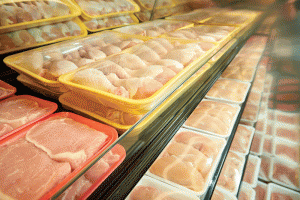
Processors who package fresh proteins, such as ground turkey, can slow microbial growth by using modified atmosphere packaging.
Image Credit: Novipax
The processors, distributors, or retailers of the food-handling industry that offer their protein products to consumers via fresh or frozen display cases wake up every morning with one mantra running through their minds, which is known as the “Three ‘Cs’ of Food Handling:” Keep it Clean, Keep it Cold, and Keep it Covered.
To ensure that these three Cs are strictly met, all of which are essential to offering proteins that are at the peak of freshness with little chance of harmful spoilage, a number of critical steps must be followed during the production and supply processes. One of the most significant, and one that also does the most to capture the eye of the consumer, is the packaging in which the protein is placed and presented.
For many years now, this packaging has consisted of a foam tray with an absorbent pad over which the protein—most commonly red meat, poultry, or seafood—is placed before it is sealed. Two grades of trays are used depending on how the food product will ultimately be offered to the consumer. If the processor packages the product, it will usually be placed in a processor tray that is of a heavier or thicker grade so that it can better survive automated packaging with high-speed machinery or the jostling that can occur during shipping. Fresh proteins that are packaged in the actual store, either in a backroom or after being selected from a display case by the consumer, are typically placed in thinner supermarket foam trays since not as much rough handling is experienced before the protein is consumed.
Key to making the proteins “sustainable,” i.e. giving them an optimized shelf life with reduced risk of spoilage or excessive levels of waste, are the pads on which the proteins rest in the packaging. There are many different types of pads that can be used depending on the specific processing or retailing application (see “Picking the Perfect Pad” sidebar), but they all perform one crucial function: wick away the fluids that come from the protein, while in the process, increasing the protein’s “case appeal” in the display window and preventing the protein from sitting in a pool of juices, which will retard the growth of microbes that can increase food-spoilage rates.
Your Friend, Carbon Dioxide

CO2-generating pads keep proteins fresh and wick away any moisture, enabling packaging to be displayed on an angle, which is more eye-catching for consumers.
Image credit: Novipax
One of the best friends of food processors and retailers when it comes to controlling microbial growth is carbon dioxide (CO2). In basic scientific terms, CO2 is detrimental to bacteria because it helps create an environment that is unfavorable to the growth of microbes. Specifically, when CO2 is exposed to a meat surface it is turned into an acid that creates a lower pH level on the meat, which helps slow bacterial growth.
While the benefits of CO2 in retarding microbial growth have long been known, the challenge for the manufacturers of the trays and pads in which proteins are packaged has been to find ways to reliably increase the CO2 level in the enclosed package. Two relatively recent technological innovations have proven to be exceptionally effective in raising CO2 levels. (Note, however, that by simply raising CO2 levels in a package that the protein will not automatically have an extended shelf life; a protein’s actual shelf life is dependent on a number of interacting factors, including how it is actually processed, how clean the processing facility is, how high the actual levels of microbes are when it is packaged, etc.)
ACCESS THE FULL VERSION OF THIS ARTICLE
To view this article and gain unlimited access to premium content on the FQ&S website, register for your FREE account. Build your profile and create a personalized experience today! Sign up is easy!
GET STARTED
Already have an account? LOGIN

